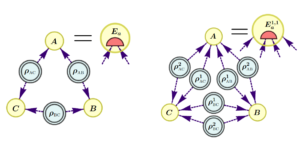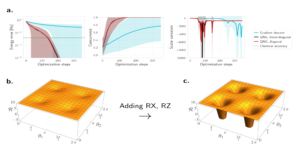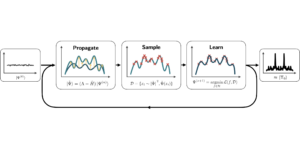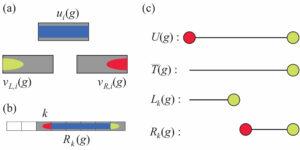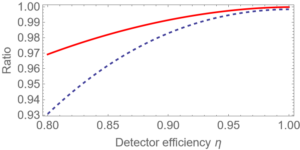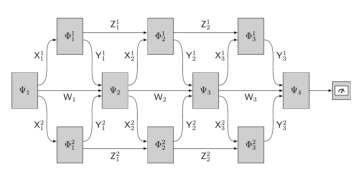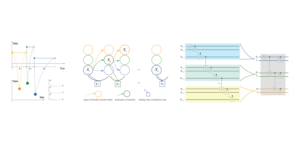1State Key Laboratory of Low-Dimensional Quantum Physics and Department of Physics, Tsinghua University, Beijing 100084, China
2China Mobile (Suzhou) Software Technology Company Limited, Suzhou 215163, China
3Beijing Academy of Quantum Information Sciences, Beijing 100193, China
4Institude of Physics, Chinese Academy of Sciences, Beijing 100190, China
5School of Physical Sciences, University of Chinese Academy of Sciences, Beijing 100190, China
6Frontier Science Center for Quantum Information, Beijing 100084, China
7Beijing National Research Center for Information Science and Technology, Beijing 100084, China
Find this paper interesting or want to discuss? Scite or leave a comment on SciRate.
Abstract
Utilizing quantum computer to investigate quantum chemistry is an important research field nowadays. In addition to the ground-state problems that have been widely studied, the determination of excited-states plays a crucial role in the prediction and modeling of chemical reactions and other physical processes. Here, we propose a non-variational full circuit-based quantum algorithm for obtaining the excited-state spectrum of a quantum chemistry Hamiltonian. Compared with previous classical-quantum hybrid variational algorithms, our method eliminates the classical optimization process, reduces the resource cost caused by the interaction between different systems, and achieves faster convergence rate and stronger robustness against noise without barren plateau. The parameter updating for determining the next energy-level is naturally dependent on the energy measurement outputs of the previous energy-level and can be realized by only modifying the state preparation process of ancillary system, introducing little additional resource overhead. Numerical simulations of the algorithm with hydrogen, LiH, H2O and NH3 molecules are presented. Furthermore, we offer an experimental demonstration of the algorithm on a superconducting quantum computing platform, and the results show a good agreement with theoretical expectations. The algorithm can be widely applied to various Hamiltonian spectrum determination problems on the fault-tolerant quantum computers.
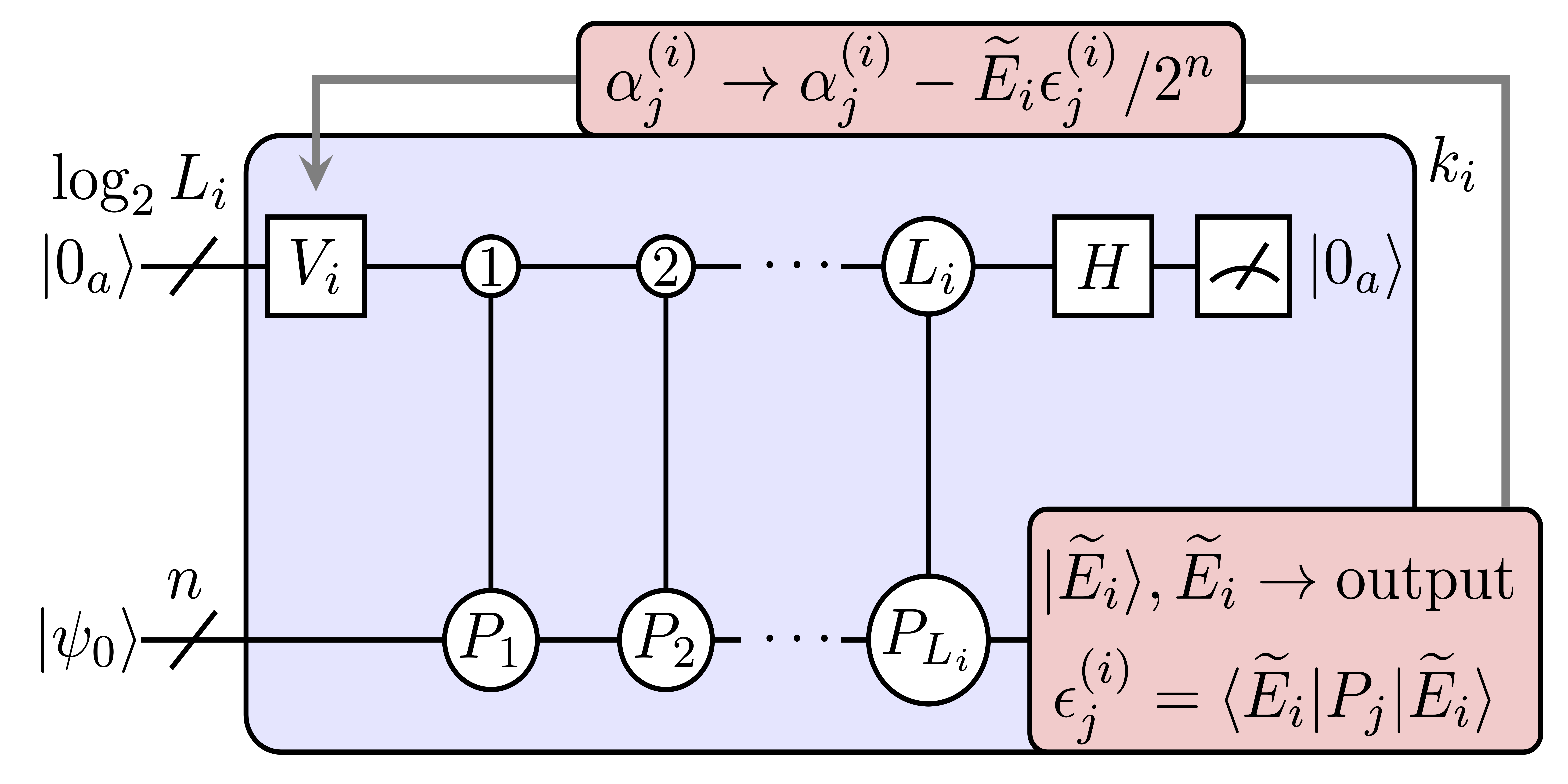
Featured image: Quantum circuit for the realization of FQESS algorithm.
Popular summary
► BibTeX data
► References
[1] Paul Benioff. The computer as a physical system: A microscopic quantum mechanical hamiltonian model of computers as represented by turing machines. Journal of statistical physics, 22 (5): 563–591, 1980. 10.1007/BF01011339.
https://doi.org/10.1007/BF01011339
[2] Richard P Feynman. Simulating physics with computers. Int J Theor Phys, 21 (1): 467–488, 1982. 10.1007/BF02650179.
https://doi.org/10.1007/BF02650179
[3] Peter W Shor. Polynomial-time algorithms for prime factorization and discrete logarithms on a quantum computer. SIAM review, 41 (2): 303–332, 1999. 10.1137/S0036144598347011.
https://doi.org/10.1137/S0036144598347011
[4] Lov K Grover. Quantum mechanics helps in searching for a needle in a haystack. Physical review letters, 79 (2): 325, 1997. 10.1103/PhysRevLett.79.325.
https://doi.org/10.1103/PhysRevLett.79.325
[5] Gui Lu Long, Yan Song Li, Wei Lin Zhang, and Li Niu. Phase matching in quantum searching. Physics Letters A, 262 (1): 27–34, 1999. 10.1016/S0375-9601(99)00631-3.
https://doi.org/10.1016/S0375-9601(99)00631-3
[6] Aram W Harrow, Avinatan Hassidim, and Seth Lloyd. Quantum algorithm for linear systems of equations. Physical review letters, 103 (15): 150502, 2009. 10.1103/PhysRevLett.103.150502.
https://doi.org/10.1103/PhysRevLett.103.150502
[7] Yiğit Subaşı, Rolando D Somma, and Davide Orsucci. Quantum algorithms for systems of linear equations inspired by adiabatic quantum computing. Physical review letters, 122 (6): 060504, 2019. 10.1103/PhysRevLett.122.060504.
https://doi.org/10.1103/PhysRevLett.122.060504
[8] Yudong Cao, Jonathan Romero, Jonathan P Olson, Matthias Degroote, Peter D Johnson, Mária Kieferová, Ian D Kivlichan, Tim Menke, Borja Peropadre, Nicolas PD Sawaya, et al. Quantum chemistry in the age of quantum computing. Chemical reviews, 119 (19): 10856–10915, 2019. 10.1021/acs.chemrev.8b00803.
https://doi.org/10.1021/acs.chemrev.8b00803
[9] Sam McArdle, Suguru Endo, Alán Aspuru-Guzik, Simon C Benjamin, and Xiao Yuan. Quantum computational chemistry. Reviews of Modern Physics, 92 (1): 015003, 2020. 10.1103/RevModPhys.92.015003.
https://doi.org/10.1103/RevModPhys.92.015003
[10] Bela Bauer, Sergey Bravyi, Mario Motta, and Garnet Kin-Lic Chan. Quantum algorithms for quantum chemistry and quantum materials science. Chemical Reviews, 120 (22): 12685–12717, 2020. 10.1021/acs.chemrev.9b00829.
https://doi.org/10.1021/acs.chemrev.9b00829
[11] Alberto Peruzzo, Jarrod McClean, Peter Shadbolt, Man-Hong Yung, Xiao-Qi Zhou, Peter J Love, Alán Aspuru-Guzik, and Jeremy L O’brien. A variational eigenvalue solver on a photonic quantum processor. Nature communications, 5 (1): 1–7, 2014. 10.1038/ncomms5213.
https://doi.org/10.1038/ncomms5213
[12] Peter JJ O’Malley, Ryan Babbush, Ian D Kivlichan, Jonathan Romero, Jarrod R McClean, Rami Barends, Julian Kelly, Pedram Roushan, Andrew Tranter, Nan Ding, et al. Scalable quantum simulation of molecular energies. Physical Review X, 6 (3): 031007, 2016. 10.1103/PhysRevX.6.031007.
https://doi.org/10.1103/PhysRevX.6.031007
[13] Abhinav Kandala, Antonio Mezzacapo, Kristan Temme, Maika Takita, Markus Brink, Jerry M Chow, and Jay M Gambetta. Hardware-efficient variational quantum eigensolver for small molecules and quantum magnets. Nature, 549 (7671): 242–246, 2017. 10.1038/nature23879.
https://doi.org/10.1038/nature23879
[14] Marco Cerezo, Andrew Arrasmith, Ryan Babbush, Simon C Benjamin, Suguru Endo, Keisuke Fujii, Jarrod R McClean, Kosuke Mitarai, Xiao Yuan, Lukasz Cincio, et al. Variational quantum algorithms. Nature Reviews Physics, pages 1–20, 2021. 10.1038/s42254-021-00348-9.
https://doi.org/10.1038/s42254-021-00348-9
[15] Xavi Bonet-Monroig, Ramiro Sagastizabal, M Singh, and TE O'Brien. Low-cost error mitigation by symmetry verification. Physical Review A, 98 (6): 062339, 2018. 10.1103/PhysRevA.98.062339.
https://doi.org/10.1103/PhysRevA.98.062339
[16] Harper R Grimsley, Sophia E Economou, Edwin Barnes, and Nicholas J Mayhall. An adaptive variational algorithm for exact molecular simulations on a quantum computer. Nature communications, 10 (1): 1–9, 2019. 10.1038/s41467-019-10988-2.
https://doi.org/10.1038/s41467-019-10988-2
[17] Ho Lun Tang, VO Shkolnikov, George S Barron, Harper R Grimsley, Nicholas J Mayhall, Edwin Barnes, and Sophia E Economou. qubit-adapt-vqe: An adaptive algorithm for constructing hardware-efficient ansätze on a quantum processor. PRX Quantum, 2 (2): 020310, 2021. 10.1103/PRXQuantum.2.020310.
https://doi.org/10.1103/PRXQuantum.2.020310
[18] Mateusz Ostaszewski, Edward Grant, and Marcello Benedetti. Structure optimization for parameterized quantum circuits. Quantum, 5: 391, 2021. 10.22331/q-2021-01-28-391.
https://doi.org/10.22331/q-2021-01-28-391
[19] Shijie Wei, Hang Li, and GuiLu Long. A full quantum eigensolver for quantum chemistry simulations. Research, 2020, 2020. 10.34133/2020/1486935.
https://doi.org/10.34133/2020/1486935
[20] Patrick Rebentrost, Maria Schuld, Leonard Wossnig, Francesco Petruccione, and Seth Lloyd. Quantum gradient descent and newton’s method for constrained polynomial optimization. New Journal of Physics, 21 (7): 073023, 2019. 10.1088/1367-2630/ab2a9e.
https://doi.org/10.1088/1367-2630/ab2a9e
[21] Oscar Higgott, Daochen Wang, and Stephen Brierley. Variational quantum computation of excited states. Quantum, 3: 156, 2019. 10.22331/q-2019-07-01-156.
https://doi.org/10.22331/q-2019-07-01-156
[22] Tyson Jones, Suguru Endo, Sam McArdle, Xiao Yuan, and Simon C Benjamin. Variational quantum algorithms for discovering hamiltonian spectra. Physical Review A, 99 (6): 062304, 2019. 10.1103/PhysRevA.99.062304.
https://doi.org/10.1103/PhysRevA.99.062304
[23] Ken M Nakanishi, Kosuke Mitarai, and Keisuke Fujii. Subspace-search variational quantum eigensolver for excited states. Physical Review Research, 1 (3): 033062, 2019. 10.1103/PhysRevResearch.1.033062.
https://doi.org/10.1103/PhysRevResearch.1.033062
[24] Robert M Parrish, Edward G Hohenstein, Peter L McMahon, and Todd J Martínez. Quantum computation of electronic transitions using a variational quantum eigensolver. Physical review letters, 122 (23): 230401, 2019. 10.1103/PhysRevLett.122.230401.
https://doi.org/10.1103/PhysRevLett.122.230401
[25] Jarrod R McClean, Mollie E Kimchi-Schwartz, Jonathan Carter, and Wibe A De Jong. Hybrid quantum-classical hierarchy for mitigation of decoherence and determination of excited states. Physical Review A, 95 (4): 042308, 2017. 10.1103/PhysRevA.95.042308.
https://doi.org/10.1103/PhysRevA.95.042308
[26] James I Colless, Vinay V Ramasesh, Dar Dahlen, Machiel S Blok, Mollie E Kimchi-Schwartz, Jarrod R McClean, Jonathan Carter, Wibe A de Jong, and Irfan Siddiqi. Computation of molecular spectra on a quantum processor with an error-resilient algorithm. Physical Review X, 8 (1): 011021, 2018. 10.1103/PhysRevX.8.011021.
https://doi.org/10.1103/PhysRevX.8.011021
[27] Pejman Jouzdani, Stefan Bringuier, and Mark Kostuk. A method of determining excited-states for quantum computation. arXiv preprint arXiv:1908.05238, 2019. 10.48550/arXiv.1908.05238.
https://doi.org/10.48550/arXiv.1908.05238
arXiv:1908.05238
[28] Pauline J Ollitrault, Abhinav Kandala, Chun-Fu Chen, Panagiotis Kl Barkoutsos, Antonio Mezzacapo, Marco Pistoia, Sarah Sheldon, Stefan Woerner, Jay M Gambetta, and Ivano Tavernelli. Quantum equation of motion for computing molecular excitation energies on a noisy quantum processor. Physical Review Research, 2 (4): 043140, 2020. 10.1103/PhysRevResearch.2.043140.
https://doi.org/10.1103/PhysRevResearch.2.043140
[29] Dan-Bo Zhang, Bin-Lin Chen, Zhan-Hao Yuan, and Tao Yin. Variational quantum eigensolvers by variance minimization. Chinese Physics B, 31 (12): 120301, 2022. 10.1088/1674-1056/ac8a8d.
https://doi.org/10.1088/1674-1056/ac8a8d
[30] Saad Yalouz, Emiel Koridon, Bruno Senjean, Benjamin Lasorne, Francesco Buda, and Lucas Visscher. Analytical nonadiabatic couplings and gradients within the state-averaged orbital-optimized variational quantum eigensolver. Journal of chemical theory and computation, 18 (2): 776–794, 2022. 10.1021/acs.jctc.1c00995.
https://doi.org/10.1021/acs.jctc.1c00995
[31] Jingwei Wen, Dingshun Lv, Man-Hong Yung, and Gui-Lu Long. Variational quantum packaged deflation for arbitrary excited states. Quantum Engineering, page e80, 2021. 10.1002/que2.80.
https://doi.org/10.1002/que2.80
[32] Pascual Jordan and Eugene Paul Wigner. über das paulische äquivalenzverbot. In The Collected Works of Eugene Paul Wigner, pages 109–129. Springer, 1993. 10.1007/978-3-662-02781-3_9.
https://doi.org/10.1007/978-3-662-02781-3_9
[33] Sergey B Bravyi and Alexei Yu Kitaev. Fermionic quantum computation. Annals of Physics, 298 (1): 210–226, 2002. 10.1006/aphy.2002.6254.
https://doi.org/10.1006/aphy.2002.6254
[34] Long Gui-Lu. General quantum interference principle and duality computer. Communications in Theoretical Physics, 45 (5): 825, 2006. 10.1088/0253-6102/45/5/013.
https://doi.org/10.1088/0253-6102/45/5/013
[35] Long Gui-Lu and Liu Yang. Duality computing in quantum computers. Communications in Theoretical Physics, 50 (6): 1303, 2008. 10.1088/0253-6102/50/6/11.
https://doi.org/10.1088/0253-6102/50/6/11
[36] Long Gui-Lu, Liu Yang, and Wang Chuan. Allowable generalized quantum gates. Communications in Theoretical Physics, 51 (1): 65, 2009. 10.1088/0253-6102/51/1/13.
https://doi.org/10.1088/0253-6102/51/1/13
[37] Andrew M Childs and Nathan Wiebe. Hamiltonian simulation using linear combinations of unitary operations. arXiv preprint arXiv:1202.5822, 2012. 10.48550/arXiv.1202.5822.
https://doi.org/10.48550/arXiv.1202.5822
arXiv:1202.5822
[38] Jingwei Wen, Chao Zheng, Xiangyu Kong, Shijie Wei, Tao Xin, and Guilu Long. Experimental demonstration of a digital quantum simulation of a general $mathcal{PT}$-symmetric system. Physical Review A, 99 (6): 062122, 2019. 10.1103/PhysRevA.99.062122.
https://doi.org/10.1103/PhysRevA.99.062122
[39] Jingwei Wen, Guoqing Qin, Chao Zheng, Shijie Wei, Xiangyu Kong, Tao Xin, and Guilu Long. Observation of information flow in the anti-$mathcal{PT}$-symmetric system with nuclear spins. npj Quantum Information, 6 (1): 1–7, 2020. 10.1038/s41534-020-0258-4.
https://doi.org/10.1038/s41534-020-0258-4
[40] Gui-Lu Long and Yang Sun. Efficient scheme for initializing a quantum register with an arbitrary superposed state. Physical Review A, 64 (1): 014303, 2001. 10.1103/PhysRevA.64.014303.
https://doi.org/10.1103/PhysRevA.64.014303
[41] Vittorio Giovannetti, Seth Lloyd, and Lorenzo Maccone. Quantum random access memory. Physical review letters, 100 (16): 160501, 2008. 10.1103/PhysRevLett.100.160501.
https://doi.org/10.1103/PhysRevLett.100.160501
[42] Gilles Brassard, Peter Hoyer, Michele Mosca, and Alain Tapp. Quantum amplitude amplification and estimation. Contemporary Mathematics, 305: 53–74, 2002. 10.1090/conm/305/05215.
https://doi.org/10.1090/conm/305/05215
[43] Dominic W Berry, Andrew M Childs, Richard Cleve, Robin Kothari, and Rolando D Somma. Simulating hamiltonian dynamics with a truncated taylor series. Physical review letters, 114 (9): 090502, 2015. 10.1103/PhysRevLett.114.090502.
https://doi.org/10.1103/PhysRevLett.114.090502
[44] Tao Xin, Shi-Jie Wei, Julen S Pedernales, Enrique Solano, and Gui-Lu Long. Quantum simulation of quantum channels in nuclear magnetic resonance. Physical Review A, 96 (6): 062303, 2017. 10.1103/PhysRevA.96.062303.
https://doi.org/10.1103/PhysRevA.96.062303
[45] Shi-Jie Wei, Tao Xin, and Gui-Lu Long. Efficient universal quantum channel simulation in ibm’s cloud quantum computer. Science China Physics, Mechanics & Astronomy, 61 (7): 1–10, 2018. 10.1007/s11433-017-9181-9.
https://doi.org/10.1007/s11433-017-9181-9
[46] Mario Napolitano, Marco Koschorreck, Brice Dubost, Naeimeh Behbood, RJ Sewell, and Morgan W Mitchell. Interaction-based quantum metrology showing scaling beyond the heisenberg limit. Nature, 471 (7339): 486–489, 2011. 10.1038/nature09778.
https://doi.org/10.1038/nature09778
[47] Detail information about Quafu cloud platform can be found at website, github, and document.
http://quafu.baqis.ac.cn/
[48] Jiangfeng Du, Nanyang Xu, Xinhua Peng, Pengfei Wang, Sanfeng Wu, and Dawei Lu. Nmr implementation of a molecular hydrogen quantum simulation with adiabatic state preparation. Physical review letters, 104 (3): 030502, 2010. 10.1103/PhysRevLett.104.030502.
https://doi.org/10.1103/PhysRevLett.104.030502
[49] Maysum Panju. Iterative methods for computing eigenvalues and eigenvectors. arXiv preprint arXiv:1105.1185, 2011. 10.48550/arXiv.1105.1185.
https://doi.org/10.48550/arXiv.1105.1185
arXiv:1105.1185
Cited by
[1] Jingwei Wen, Chao Zheng, Zhiguo Huang, and Ling Qian, "Iteration-free digital quantum simulation of imaginary-time evolution based on the approximate unitary expansion", EPL (Europhysics Letters) 141 6, 68001 (2023).
[2] Bozhi Wang, Jingwei Wen, Jiawei Wu, Haonan Xie, Fan Yang, Shijie Wei, and Gui-lu Long, "A powered full quantum eigensolver for energy band structures", arXiv:2308.03134, (2023).
[3] Jin-Min Liang, Qiao-Qiao Lv, Shu-Qian Shen, Ming Li, Zhi-Xi Wang, and Shao-Ming Fei, "Improved iterative quantum algorithm for ground-state preparation", arXiv:2210.08454, (2022).
[4] Xin Yi, Jia-Cheng Huo, Yong-Pan Gao, Ling Fan, Ru Zhang, and Cong Cao, "Iterative quantum algorithm for combinatorial optimization based on quantum gradient descent", Results in Physics 56, 107204 (2024).
The above citations are from SAO/NASA ADS (last updated successfully 2024-01-04 14:13:50). The list may be incomplete as not all publishers provide suitable and complete citation data.
Could not fetch Crossref cited-by data during last attempt 2024-01-04 14:13:48: Could not fetch cited-by data for 10.22331/q-2024-01-04-1219 from Crossref. This is normal if the DOI was registered recently.
This Paper is published in Quantum under the Creative Commons Attribution 4.0 International (CC BY 4.0) license. Copyright remains with the original copyright holders such as the authors or their institutions.
- SEO Powered Content & PR Distribution. Get Amplified Today.
- PlatoData.Network Vertical Generative Ai. Empower Yourself. Access Here.
- PlatoAiStream. Web3 Intelligence. Knowledge Amplified. Access Here.
- PlatoESG. Carbon, CleanTech, Energy, Environment, Solar, Waste Management. Access Here.
- PlatoHealth. Biotech and Clinical Trials Intelligence. Access Here.
- Source: https://quantum-journal.org/papers/q-2024-01-04-1219/
- :is
- :not
- ][p
- 1
- 10
- 100
- 11
- 114
- 12
- 120
- 13
- 14
- 15%
- 16
- 17
- 19
- 1999
- 20
- 2001
- 2006
- 2008
- 2010
- 2011
- 2012
- 2014
- 2015
- 2016
- 2017
- 2018
- 2019
- 2020
- 2021
- 2022
- 2023
- 2024
- 22
- 23
- 24
- 25
- 26
- 27
- 28
- 29
- 30
- 31
- 32
- 33
- 35%
- 36
- 39
- 40
- 41
- 43
- 46
- 49
- 50
- 51
- 65
- 7
- 8
- 80
- 9
- 98
- a
- About
- above
- ABSTRACT
- AC
- Academy
- access
- Achieves
- adaptive
- addition
- Additional
- affiliations
- against
- age
- Agreement
- AL
- algorithm
- algorithms
- All
- along
- Amplification
- an
- Analytical
- and
- Andrew
- applied
- approximate
- ARE
- AS
- astronomy
- At
- attempt
- author
- authors
- avoiding
- b
- BAND
- barren
- based
- BE
- been
- Beijing
- Benjamin
- between
- Beyond
- BLOK
- Break
- brice
- brink
- Bruno
- by
- CAN
- caused
- Center
- chan
- Channel
- channels
- chemical
- chemistry
- chen
- China
- chinese
- chow
- Cloud
- Cloud Platform
- combinations
- comment
- Commons
- Communications
- company
- compared
- complete
- computation
- computational
- computer
- computers
- computing
- constructing
- contemporary
- Convergence
- copyright
- Cost
- could
- crucial
- data
- deflation
- Den
- Department
- dependent
- detail
- determination
- determining
- different
- digital
- direction
- discovering
- discuss
- document
- during
- dynamics
- e
- E&T
- Edward
- Edwin
- efficient
- efficiently
- Electronic
- eliminates
- energy
- Engineering
- ensure
- equations
- error
- Ether (ETH)
- eugene
- evolution
- excited
- expansion
- expectations
- experimental
- fan
- faster
- fastest
- fei
- field
- fills
- flow
- For
- found
- friendly
- from
- full
- Furthermore
- future
- GAO
- Gates
- General
- George
- Gilles
- GitHub
- good
- gradients
- grant
- Hang
- harvard
- Have
- helps
- here
- hierarchy
- holders
- http
- HTTPS
- huang
- Hybrid
- hybrid quantum-classical
- hydrogen
- i
- if
- image
- implementation
- important
- improved
- in
- information
- inspired
- institutions
- interaction
- interesting
- interference
- International
- introducing
- investigate
- james
- Jan
- JavaScript
- jj
- Johnson
- jonathan
- jones
- Jordan
- journal
- Key
- Kong
- laboratory
- Last
- Leave
- leonard
- li
- License
- LIMIT
- Limited
- lin
- List
- little
- Long
- love
- low-cost
- Machines
- Magnets
- Marco
- maria
- Mario
- mark
- matching
- materials
- mathematics
- matthias
- max-width
- May..
- mcclean
- measurement
- mechanical
- mechanics
- Memory
- method
- methods
- Metrology
- minimization
- mitigation
- Mobile
- model
- modeling
- Modern
- molecular
- Month
- Moreover
- Morgan
- motion
- National
- Nature
- New
- next
- nicholas
- Nicolas
- Noise
- normal
- nuclear
- observation
- obtaining
- of
- offer
- on
- only
- open
- Operations
- optimization
- or
- original
- Other
- our
- outputs
- packaged
- page
- pages
- Paper
- parameter
- patrick
- Paul
- Peter
- phase
- phenomenon
- physical
- Physical Sciences
- Physics
- platform
- plato
- Plato Data Intelligence
- PlatoData
- plays
- powered
- prediction
- preparation
- presented
- previous
- Prime
- principle
- problems
- process
- processes
- Processor
- propose
- provide
- published
- publisher
- publishers
- Quantum
- quantum algorithms
- Quantum Computer
- quantum computers
- quantum computing
- quantum information
- quantum materials
- Quantum Mechanics
- quantum physics
- R
- RAMI
- random
- Rate
- reactions
- realization
- realized
- recently
- reduces
- references
- register
- registered
- remains
- removes
- represented
- research
- resonance
- resource
- Results
- review
- Reviews
- Richard
- ROBERT
- Robin
- robustness
- Role
- RU
- Ryan
- s
- SAAD
- Sam
- scalable
- scaling
- scheme
- Science
- Science and Technology
- SCIENCES
- searching
- Series
- show
- showing
- siam
- Simon
- simply
- simulation
- small
- Software
- Solving
- song
- sophia
- Spectrum
- spins
- State
- States
- statistical
- steadily
- stefan
- Step
- Stephen
- stronger
- structure
- structures
- studied
- Successfully
- such
- suitable
- Sun
- suzhou
- system
- Systems
- tang
- Target
- taylor
- Technology
- that
- The
- The State
- their
- theoretical
- theory
- this
- Tim
- Title
- to
- todd
- transitions
- Tsinghua
- turing
- under
- Universal
- university
- updated
- updating
- URL
- using
- various
- Verification
- volume
- W
- wang
- want
- was
- we
- Website
- which
- widely
- with
- within
- without
- Work
- works
- wu
- X
- xiao
- year
- Yuan
- zephyrnet
- zhang

